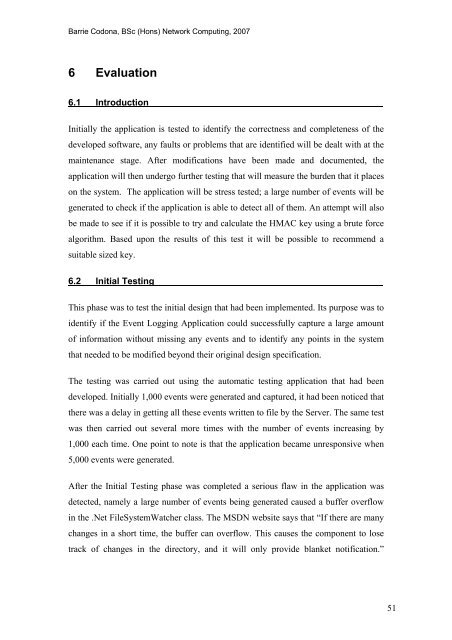Analysis and Evaluation of the Windows Event Log - Bill Buchanan
Analysis and Evaluation of the Windows Event Log - Bill Buchanan
Analysis and Evaluation of the Windows Event Log - Bill Buchanan
Create successful ePaper yourself
Turn your PDF publications into a flip-book with our unique Google optimized e-Paper software.
Barrie Codona, BSc (Hons) Network Computing, 2007<br />
6 <strong>Evaluation</strong><br />
6.1 Introduction<br />
Initially <strong>the</strong> application is tested to identify <strong>the</strong> correctness <strong>and</strong> completeness <strong>of</strong> <strong>the</strong><br />
developed s<strong>of</strong>tware, any faults or problems that are identified will be dealt with at <strong>the</strong><br />
maintenance stage. After modifications have been made <strong>and</strong> documented, <strong>the</strong><br />
application will <strong>the</strong>n undergo fur<strong>the</strong>r testing that will measure <strong>the</strong> burden that it places<br />
on <strong>the</strong> system. The application will be stress tested; a large number <strong>of</strong> events will be<br />
generated to check if <strong>the</strong> application is able to detect all <strong>of</strong> <strong>the</strong>m. An attempt will also<br />
be made to see if it is possible to try <strong>and</strong> calculate <strong>the</strong> HMAC key using a brute force<br />
algorithm. Based upon <strong>the</strong> results <strong>of</strong> this test it will be possible to recommend a<br />
suitable sized key.<br />
6.2 Initial Testing<br />
This phase was to test <strong>the</strong> initial design that had been implemented. Its purpose was to<br />
identify if <strong>the</strong> <strong>Event</strong> <strong>Log</strong>ging Application could successfully capture a large amount<br />
<strong>of</strong> information without missing any events <strong>and</strong> to identify any points in <strong>the</strong> system<br />
that needed to be modified beyond <strong>the</strong>ir original design specification.<br />
The testing was carried out using <strong>the</strong> automatic testing application that had been<br />
developed. Initially 1,000 events were generated <strong>and</strong> captured, it had been noticed that<br />
<strong>the</strong>re was a delay in getting all <strong>the</strong>se events written to file by <strong>the</strong> Server. The same test<br />
was <strong>the</strong>n carried out several more times with <strong>the</strong> number <strong>of</strong> events increasing by<br />
1,000 each time. One point to note is that <strong>the</strong> application became unresponsive when<br />
5,000 events were generated.<br />
After <strong>the</strong> Initial Testing phase was completed a serious flaw in <strong>the</strong> application was<br />
detected, namely a large number <strong>of</strong> events being generated caused a buffer overflow<br />
in <strong>the</strong> .Net FileSystemWatcher class. The MSDN website says that “If <strong>the</strong>re are many<br />
changes in a short time, <strong>the</strong> buffer can overflow. This causes <strong>the</strong> component to lose<br />
track <strong>of</strong> changes in <strong>the</strong> directory, <strong>and</strong> it will only provide blanket notification.”<br />
51










![Unit 5. Switches and VLANs [PDF]](https://img.yumpu.com/34422504/1/184x260/unit-5-switches-and-vlans-pdf.jpg?quality=85)





